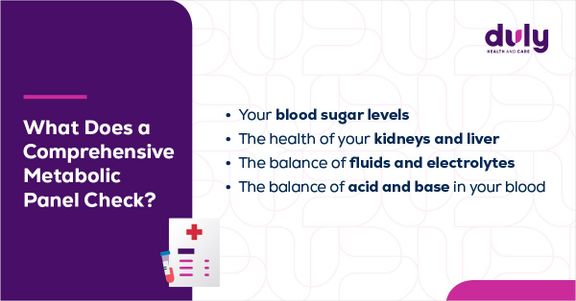At your annual physical, your healthcare provider does routine tests — some of which you may not even think twice about. They listen to your heart and your lungs, check your blood pressure, and sometimes, send you for a routine blood test called a comprehensive metabolic panel.
A comprehensive metabolic panel (CMP) is a blood test that can diagnose and monitor a wide range of health conditions, like liver disease, kidney disease, diabetes, and high blood pressure. It’s also often used as a screening tool, meaning it’s done even when you don’t have symptoms of a condition.
CMPs are similar to basic metabolic panels (BMPs), but CMPs also include six additional liver enzyme and protein tests. This gives CMPs a total of 14 individual measurements that reveal a lot about your health. Both are different from complete blood counts (CBCs), which measure your blood cells, platelets, and hemoglobin.

However, reading your comprehensive metabolic panel results can be confusing and overwhelming. Here’s how to interpret your CMP results and what they might say about your health.
How to Read Your Comprehensive Metabolic Panel Results
When you receive your CMP results, you’ll see 14 specific substances, along with a number. This shows how much of each substance is in your blood. Using this number — along with the normal range of that substance — your healthcare provider can find, diagnose, and manage treatment for health conditions.
Substance: Albumin
Purpose: A protein made by your liver. It moves substances (like hormones and medication) through your bloodstream and keeps fluid in your blood vessels.
Normal Range: 3.4 to 5.4 g/dL (1 to 54 g/L
Substance: ALP (alkaline phosphatase)
Purpose: An enzyme found in your kidneys, liver, and bones. Its exact function isn’t known, but it’s connected with health conditions like tissue damage and problems with bodily processes.
Normal Range: 1 to 130 U/L
Substance: ALT (alanine aminotransferase)
Purpose: An enzyme found primarily in your liver and is used to assess the health of your liver.
Normal Range: 1 to 36 U/L
Substance: AST (aspartate aminotransferase)
Purpose: An enzyme found in the liver, muscles, and heart and is used to assess the health of your liver.
Normal Range: 1 to 33 U/L
Substance: BUN (blood urea nitrogen)
Purpose: A normal waste product that your kidneys filter out of your blood. If kidney function slows, BUN levels can go up.
Normal Range: 6 to 20 mg/dL (2.14 to 7.14 mmol/L)
Substance: Chloride
Purpose: An electrolyte that helps control fluid in your body.
Normal Range: 96 to 106 mEq/L (96 to 106 mmol/L)
Substance: CO2 (carbon dioxide)
Purpose: An electrolyte that helps control fluid in your body.
Normal Range: 23 to 29 mEq/L (23 to 29 mmol/L)
Substance: Creatinine
Purpose: A normal waste product of muscle activity. Too much of it can indicate problems with your kidneys.
Normal Range: 0.6 to 1.3 mg/dL (53 to 114.9 µmol/L)
Substance: Glucose (sugar)
Purpose: A type of sugar that provides energy for your brain and body. High glucose levels can be a sign of diabetes.
Normal Range: 70 to 100 mg/dL (3.9 to 5.6 mmol/L)
Substance: Potassium
Purpose: A mineral that helps your heart beat regularly and muscles work properly.
Normal Range: 3.7 to 5.2 mEq/L (3.70 to 5.20 mmol/L)
Substance: Sodium
Purpose: A mineral found in many foods. A buildup of sodium can indicate kidney problems.
Normal Range: 135 to 145 mEq/L (135 to 145 mmol/L)
Substance: Serum calcium
Purpose: A mineral (which is mostly stored in your bones, but also in your blood) that helps with blood clotting, maintaining a regular heartbeat, and nerve function.
Normal Range: 8.5 to 10.2 mg/dL (2.13 to 2.55 mmol/L)
Substance: Total bilirubin
Purpose: A normal waste product made from breaking down red blood cells. A buildup of bilirubin can indicate liver problems.
Normal Range: 0.1 to 1.2 mg/dL (2 to 21 µmol/L)
Substance: Total protein
Purpose: Molecules that help your body heal, build muscle, fight infections, and stay healthy.
Normal Range: 6.0 to 8.3 g/dL (60 to 83 g/L)
What if One of the Substances in My CMP is Out of the Normal Range?
A comprehensive metabolic panel is designed to give an overview of your health. If one or more CMP results are abnormal, it might point to health conditions, like liver disease, kidney disease, diabetes, or high blood pressure.
However, a high or low number is not always an indication of a problem on its own. Usually, further testing needs to be done if one of the substance levels falls outside the normal range.
If you have questions about your CMP, talk to your healthcare provider. They can explain what your numbers mean and what they might reveal about your health.
Is it time for your annual physical and comprehensive metabolic panel? Schedule an appointment with a Duly Primary Care Provider today.
Comprehensive Metabolic Panels: A Window Into Your Health
CMPs are a great way to keep an eye on your health by detecting or monitoring health conditions. They give a view of what’s happening in your body and whether processes are occurring as they should — all with a simple blood test.
Along with other screening tests and regular health checkups, CMPs help you and your provider stay on top of your health now and for years to come.
Health Topics:







